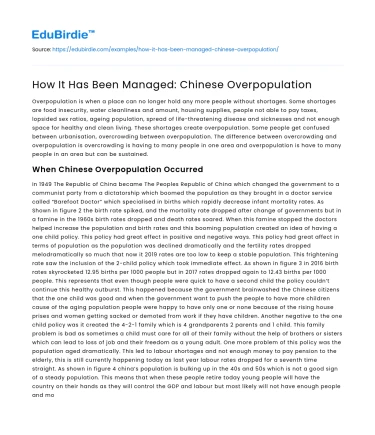Introduction
China, the world's most populous nation, has long been confronted with the challenges of overpopulation. This demographic phenomenon has profound implications on the country's economic, social, and environmental landscape. By the late 20th century, the Chinese government recognized that unchecked population growth could hinder sustainable development and exacerbate poverty. This realization led to the implementation of various population control measures, most notably the one-child policy, which was later replaced by a two-child policy. These policies have been subject to much debate regarding their effectiveness and ethical implications. This essay explores how China has managed overpopulation through governmental policies, the socio-economic impacts of these measures, and the ongoing challenges in balancing population control with individual rights. By examining these aspects, we aim to understand the complexities of managing population growth in a rapidly changing society.
Governmental Policies and Their Impact
The Chinese government has employed several strategies to manage its burgeoning population, with the one-child policy being the most significant. Introduced in 1979, this policy aimed to curb population growth by limiting urban couples to a single child. According to the National Health and Family Planning Commission, the policy prevented approximately 400 million births. However, this drastic measure also led to unintended consequences, including an aging population and a gender imbalance due to a cultural preference for male children. A study by Wang Feng, a demographer, noted that "the one-child policy has achieved its goal of reducing population growth, but it has also created new challenges for China's future."
In response to these challenges, China relaxed its one-child policy in 2015, allowing couples to have two children. This shift aimed to mitigate the effects of an aging population and ensure a stable labor force. Despite the policy change, birth rates have not significantly increased, as economic pressures and changing societal norms deter many couples from having more children. The government's attempts to address overpopulation through policy adjustments highlight the complexity of demographic management and the need for adaptive strategies.
Socio-Economic Implications of Population Control
The socio-economic implications of China's population control measures are multifaceted. On one hand, the one-child policy contributed to economic growth by reducing the dependency ratio, allowing more resources to be allocated per child, and facilitating investments in education and healthcare. According to the World Bank, China's GDP growth rate averaged 10% annually from 1980 to 2015, partly due to the demographic dividend. This economic boom lifted millions out of poverty and transformed China into a global economic powerhouse.
On the other hand, the population control measures have led to significant social challenges. The reduction in birth rates has resulted in an aging population, with the proportion of people aged 60 and above expected to reach 34% by 2050. This demographic shift places immense pressure on social services and the younger workforce, who bear the financial burden of caring for the elderly. Additionally, the gender imbalance, exacerbated by the one-child policy, has led to societal issues such as increased rates of human trafficking and difficulties for men in finding spouses. These socio-economic challenges underscore the need for comprehensive policies that address the long-term consequences of population control.
Ongoing Challenges and Future Directions
Despite efforts to manage overpopulation, China continues to face ongoing challenges that require innovative solutions. The transition from the one-child to the two-child policy has not reversed the declining birth rates, indicating a need for policies that address the underlying socio-economic factors influencing family planning decisions. Addressing issues such as high living costs, inadequate parental leave, and insufficient childcare support are crucial in encouraging higher birth rates.
Moreover, the government must balance population control with individual rights, ensuring that policies do not infringe on personal freedoms. Critics argue that coercive measures violate human rights, advocating for a more voluntary approach to family planning. The Chinese government has begun to recognize this, with recent policies focusing on improving healthcare and education, rather than strict population control. As China navigates these demographic challenges, it must adopt a holistic approach that considers the well-being of its citizens while ensuring sustainable development.
Conclusion
China's journey in managing overpopulation highlights the intricate interplay between policy, socio-economic factors, and demographic trends. While the one-child policy achieved its goal of reducing population growth, it also introduced new challenges that continue to affect the country. The shift to a two-child policy represents a step towards addressing these issues, but further efforts are needed to create a sustainable demographic future. By considering the socio-economic needs of its citizens and respecting individual rights, China can develop policies that promote both population stability and human welfare. As the country continues to evolve, its experience offers valuable lessons for other nations grappling with similar challenges.






 Stuck on your essay?
Stuck on your essay?

